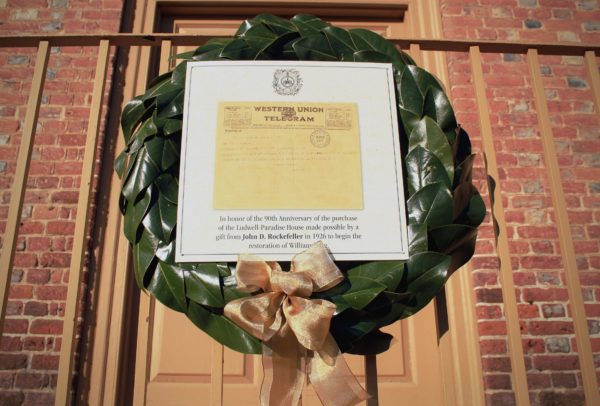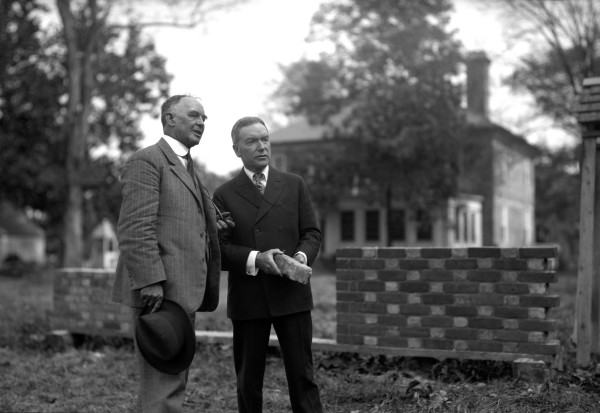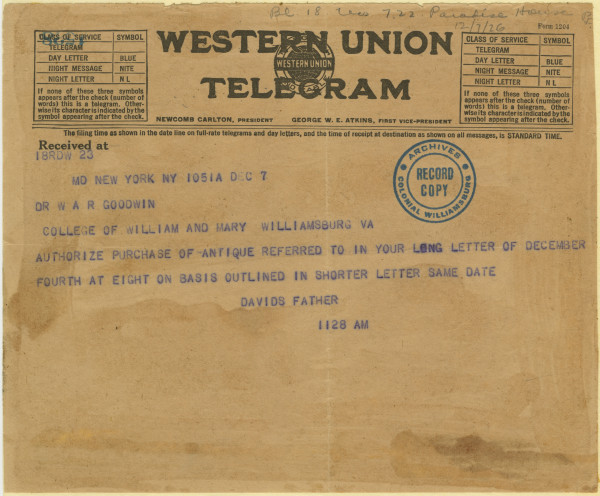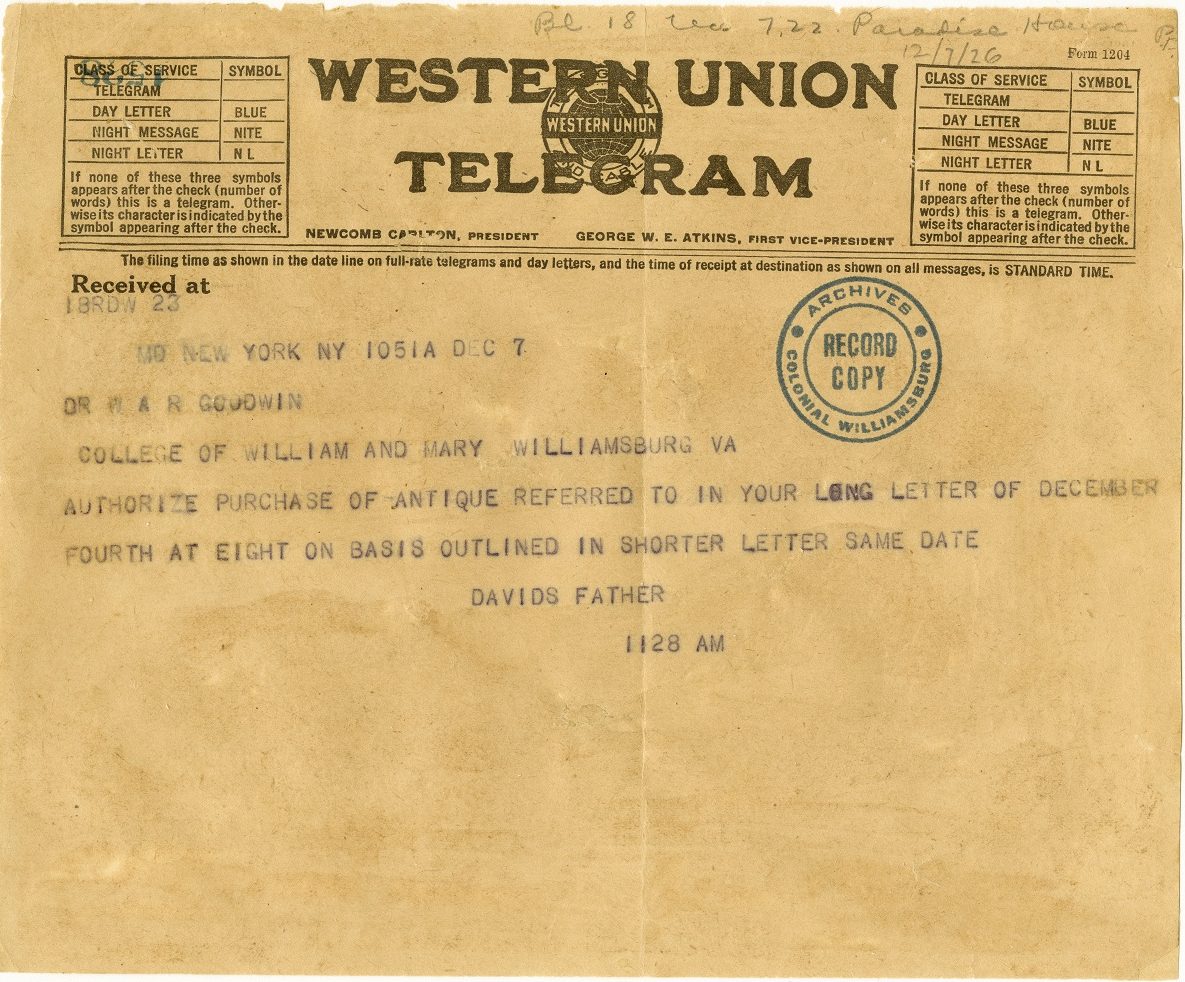
Presumably it was one of Mr. Rockefeller’s junior employees who stepped into the Western Union office on that morning in early December. In all likelihood, neither he nor the telegraph operator had an inkling that the origin story of Colonial Williamsburg was passing through their hands.
But at 10:51 a.m. on Dec, 7, 90 years ago today, an obscurely-worded message from “Davids father” was sent over the telegraph lines from New York City to Williamsburg, an event that we mark as the birthdate of the restoration of the colonial capital.
It read: “Authorize purchase of antique referred to in your long letter of December fourth at eight on basis outlined in shorter letter same date.”
The recipient was Rev. Dr. W.A.R. Goodwin, the rector of Bruton Parish Church, who had been lobbying for support for his dream of resurrecting surviving fragments of the 18th century so that Williamsburg might serve as a shrine to America’s founding.

Rev. Dr. W.A.R. Goodwin and John D. Rockefeller, Jr.
The sender was, of course, the industrial magnate John D. Rockefeller, Jr., who had already begun to dip his toes in Virginia’s historical waters, purchasing an option on Brandon Plantation, about 12 miles west of Williamsburg as the crow flies, in January 1925.
The following March, Rockefeller brought his family to Tidewater Virginia to check out the plantation and visit the area. Along with his wife Abby, four sons came along: Nelson, Laurance, Winthrop, and 11-year-old David.
Goodwin gave them the grand tour of the sites he was so excited about, the place where (because Northerners had it all wrong) the push for independence really began. He reportedly hit it off quite well with young David, hence the appropriateness of John D.’s nom de plume, “David’s father.”
Above: The original “David’s father” telegram, before and after its recent conservation. The telegram is on display at the John D. Rockefeller Jr. Library at 313 First St., Monday through Friday, 9 a.m.–5 p.m., through Dec. 16.
Rockefeller returned to help dedicate Phi Beta Kappa Hall in November, a trip which seemed to cement his interest in Goodwin’s scheme, and his appreciation for his discretion. He committed $10,000 to investigate the restoration of the Wren Building at the corner of the College of William & Mary’s campus, and pledged to match funds raised to renovate the Wythe House, which Goodwin had purchased for the use of Bruton Parish.
Rev. Goodwin and Mr. Rockefeller.
While Rockefeller was gradually increasing his commitment to Goodwin’s ideas, he had good reason to conceal his identity. The project, it was feared, would become untenable if real estate process were set less by the current market than by the deep pockets of the lone interested buyer.
Rev. Goodwin was a willing co-conspirator in the misdirection. Many knew he had been trying to find a benefactor for his grand vision. Henry Ford officially turned down his entreaties in 1924. (Perhaps Goodwin’s letter accusing Ford of hastening the destruction of Williamsburg with the introduction of his automobiles, and the paved streets that accompanied them, was not helpful to his cause.)
The man of the cloth went so far as to leave faux letters in plain sight to throw snooping visitors to his office off the scent. The envelopes were addressed to other plausible financial backers, with names like Morgan and Vanderbilt and Ford.
Before its restoration, the Ludwell-Paradise House, left, had a front porch. A service station stood to its right.
When Goodwin ran into a real estate agent representing the owner of the 18th-century Paradise House, he drafted a memo seeking Rockefeller authorization to make building purchases on his behalf when such opportunities arose.
This was the “antique” of the Dec. 7 telegram. Although the need to act quickly was perhaps not as immediate as Goodwin believed it to be, this exchange was the decisive moment when the project started to become real. Rockefeller was the silent partner behind the purchase of what we presently call the Ludwell-Paradise House. A succession of other purchases followed.
The Ludwell-Paradise House in 1931.
The wealthy New Yorker’s involvement was finally revealed to the public in a “mass meeting” held on June 12, 1928. (For a closer look at documents related to this early history of Colonial Williamsburg, please take a look at the online exhibit put together by our John D. Rockefeller, Jr. Library and Archives staff, which will tell our story over the course of our 90th anniversary year.)
It would be easy to underestimate the accomplishment of Colonial Williamsburg, much less its growth. Between Rev. Goodwin’s heroic labors and the Rockefeller’s exceptional philanthropy, the restoration was a truly improbable feat. So much might have gone wrong. Just the week before agreeing to finance the purchase of the Ludwell-Paradise House, Rockefeller himself had written to Goodwin that, beyond a few pockets where the old buildings still stood, “any effort to reproduce the conditions as they existed along the main street leading to the College would be quite impossible.”
David Rockefeller during a 2001 visit to Williamsburg, flanked by Historic Area VP Rex Ellis, left, and Garland Wood, now Master of the Shop for the Carpenters.
Yet here we are. Ninety years later, the dream—of inspiring people from all walks of life, and from all parts of the world, with the story of America’s beginnings—continues to move forward. The reconstruction is not merely the bricks and mortar of projects like the Public Armoury and the Market House, it’s the ongoing effort to better understand our story, warts and all, and to learn from it.
Today the responsibility for protecting the legacy of John D. Rockefeller, Jr. and Rev. Goodwin falls to all of us. Join us in the reconstruction. Philanthropy made the dream possible, and it keeps the Foundation operating today. Please support Colonial Williamsburg’s mission at whatever level you can afford.



Great story Bill. Well done!
Just imagine if the Reverend Goodwin did not have this vision. How many people would have stood in the middle of Williamsburg at that time and dreamed that it could become THIS?
And the uniqueness of John Rockefeller to catch the vision and buy in?
Imagine the loss to the world if the vision wasn’t born, in one man and completely supported by a man who had the means.
Happy Birthday!
We visited Colonial Williamsburg for the first time this past June.
Needless to say we had an amazing time!
So amazing, in fact, that I wrote a six-post series about it in my Passion for the Past blog, which includes hundreds of pictures.
http://passionforthepast.blogspot.com/2016/10/happy-independence-day-2016-visiting.html
I hope to return one day in the not-to-distant- future…
I and the wife really enjoyed this history lesson.
I love this story of Dr. Goodwin’s vision of a restored Colonial Williamsburg and his persistence in making it a reality. Each time I read the story it also increases my respect for Mr. Rockefeller and his family. Their interest and generosity have benefited millions. Happy Birthday to Colonial Williamsburg!
I love this - a priest engaged in subterfuge! Thank goodness he persuaded Mr Rockefeller to take action.
EXCELLENT message! Happy Birthday, Colonial Williamsburg! (And remember Pearl Harbor!)